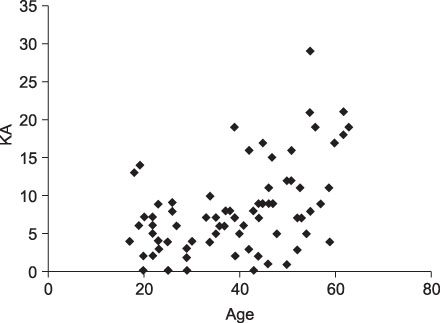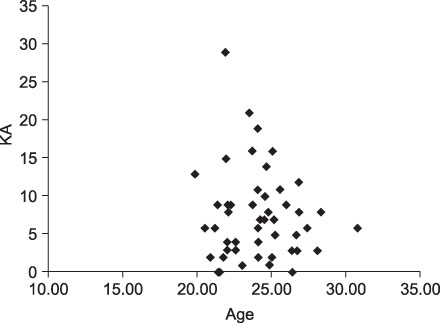J Korean Orthop Assoc.
2007 Dec;42(6):808-814. 10.4055/jkoa.2007.42.6.808.
Clinical Efficacy of Implant Removal after Posterior Spinal Arthrodesis with Pedicle Screw Fixation for the Thoracolumbar Burst Fractures
- Affiliations
-
- 1Department of Orthopedic Surgery, College of Medicine, Research Institute of Clinical Medicine, Chonbuk National University, Jeonju, Korea. jrkeem@chonbuk.ac.kr
- KMID: 1947789
- DOI: http://doi.org/10.4055/jkoa.2007.42.6.808
Abstract
-
PURPOSE: To evaluate the clinical efficacy of implant removal by analyzing the radiological changes after posterior spinal stabilization in patients with thoracolumbar burst fractures.
MATERIALS AND METHODS
Fifty-eight patients, who received surgical treatment after a thoracolumbar burst fracture with at least a two year follow-up, were enrolled in this study. An evaluation of the clinical results was based on the VAS score to examine degree of pain and discomfort. The evaluation of the radiological results was performed by measuring the changes in the kyphotic angle of the fractured vertebral bodies and the severity of the collapse of the anterior vertebral height taken after the injury, after fusion and after metal removal on the plain lateral radiograph.
RESULTS
The VAS score on pain and discomfort after removing the implants showed a significant decrease from 6.5 to 3.2 and from 5.6 to 2.8, respectively. Overall, the kyphotic angle after removing the implants increased by 3.7 degrees, whereas the anterior height of the fractured vertebral body after removing the implant decreased by 1.5% in correction.
CONCLUSION
The removal of implants after posterior arthrodesis in thoracolumbar burst fractures can be performed effectively to relieve the pain and restore flexibility but can result in the progression of kyphosis. However careful consideration should be made before removing an implant in cases of severe initial damage.
Figure
Reference
-
1. Ahn JS, Lee JK, Hwang DS, Kim YM, Kim WJ, Byun KH. The change of kyphotic angle and anterior vertebral height after posterior or posterolateral fusion with transpedicular screws for thoracolumbar bursting fractures. J Korean Fracture Soc. 1999. 12:379–387.
Article2. Deckey JE, Court C, Bradford DS. Loss of sagittal plane correction after removal of spinal implants. Spine. 2000. 25:2453–2460.
Article3. Denis F. Spinal instability as defined by three-column spine concept in acute spinal trauma. Clin Orthop Relat Res. 1984. 189:65–76.4. Denis F. The three column spine and its significance in the classification of acute thoracolumbar spinal injuries. Spine. 1983. 8:817–831.
Article5. Dickson JH, Harrington PR, Erwin WD. Results of reduction and stabilization of the severely fractured thoracic and lumbar spine. J Bone Joint Surg Am. 1978. 60:799–805.
Article6. Esses SI, Botsford DJ, Kostuik JP. Evaluation of surgical treatment for burst fractures. Spine. 1990. 15:667–673.
Article7. Hume M, Capen DA, Nelson RW, Nagelberg S, Thomas JC Jr. Outcome after Wiltse pedicle screw removal. J Spinal Disord. 1996. 9:121–124.
Article8. Kaye JJ, Nance EP Jr. Thoracic and lumbar spine trauma. Radiol Clin North Am. 1990. 28:361–377.9. Kim NH, Kim DW. The care of patients with paralysis caused by thoracic, thoraco-lumbar, lumbar spine injuries. J Korean Orthop Assoc. 1989. 24:1678–1685.10. Kim SK, Byun YS, Lee SW. Surgical treatment of thoracolumbar fractures with transpedicular screws. J Korean Orthop Assoc. 1993. 28:607–615.
Article11. Malcolm BW, Bradford DS, Winter RB, Chou SN. Post-traumatic kyphosis. A review of forty-eight surgically treated patients. J Bone Joint Surg Am. 1981. 63:891–899.
Article12. Myllynen P, Bostman O, Riska E. Recurrence of deformity after removal of Harrington's fixation of spine fracture. Seventy-six cases followed for 2 years. Acta Orthop Scand. 1988. 59:497–502.
Article13. Panjabi MM, Oxland TR, Kifune M, Arand M, Wen L, Chen A. Validity of the three-column theory of thoracolumbar fractures. Spine. 1995. 20:1122–1127.
Article14. Weinstein JN, Collalto P, Lehmann TR. Thoracolumbar "burst" fractures treated conservatively: a long-term follow-up. Spine. 1988. 13:33–38.
Article
- Full Text Links
- Actions
-
Cited
- CITED
-
- Close
- Share
- Similar articles
-
- Short Segment versus Long Segment Pedicle Screws Fixation in Management of Thoracolumbar Burst Fractures: Meta-Analysis
- Percutaneous Pedicle Screw Fixation in Thoracolumbar Fractures: Comparison of Results According to Implant Removal Time
- More than 5-Year Follow-up Results of Two-Level and Three-Level Posterior Fixations of Thoracolumbar Burst Fractures with Load-Sharing Scores of Seven and Eight Points
- Comparison of Posterior Fixation Alone and Supplementation with Posterolateral Fusion in Thoracolumbar Burst Fractures
- Comparison of Percutaneous versus Open Pedicle Screw Fixation for Treating Unstable Thoracolumbar Fractures



